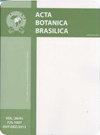The Ferns of the Calilegua National Park: a look through their spores. Part I
IF 1.1
4区 生物学
Q4 PLANT SCIENCES
引用次数: 0
Abstract
Calilegua National Park is located in the Southeast of the province of Jujuy, Argentina. It is comprised of different districts within the Yungas Biogeographic Province, where conditions are optimal for fern development. The palynological studies with light microscopy in this area are very limited. The aim of this work is to present the morphology of spores from 42 taxa belonging to 9 families of isosporate ferns that grow in this protected area. The study was carried out with herbarium material. The families studied are Anemiaceae, Aspleniaceae, Athyriaceae, Blechnaceae, Cyatheaceae, Cystopteridaceae, Dennstaedtiaceae, Dryopteridaceae, and Equisetaceae. According to the spore aperture type, 35 taxa are monolete, five trilete, and two alete. The spores are yellowish, light to dark brown or brown greenish. The largest spores belong to Anemia australis and the smallest to Asplenium argentinum. Equinate, folded, cristate, alate, reticulate, ridged, psilate, verrucate, and baculate spores were observed. For the first time, the spores of 27 species are illustrated under a light microscope. An identification key of the spores is also provided. The morphological characteristics of the spores allowed for the identification of 23 species, contributing to spore bank analysis, aeropalynological and paleopalynological studies, and taxonomic identifications.卡利列瓜国家公园的蕨类植物:透过孢子看一看。第一部分
卡利列瓜国家公园位于阿根廷胡胡伊省东南部。它由Yungas生物地理省的不同地区组成,那里的条件最适合蕨类植物的生长。在这一地区,光学显微镜下的孢粉学研究非常有限。本研究的目的是对生长在该保护区的异孢子蕨类植物9科42个分类群的孢子形态进行研究。这项研究是用植物标本室的材料进行的。所研究的科有羊蹄科、羊蹄科、羊蹄科、羊蹄科、Cyatheaceae、Cystopteridaceae、Dennstaedtiaceae、毛蕨科和木贼科。按孢子孔径类型划分,35个类群为单孢子体,5个为三孢子体,2个为双孢子体。孢子呈淡黄色,浅至深棕色或棕绿色。最大的孢子属于南方贫血,最小的孢子属于阿根廷贫血。观察到马蹄状、折叠状、鸡冠状、锯齿状、网状、脊状、柱状、疣状和杆状孢子。首次在光学显微镜下展示了27个物种的孢子。还提供了孢子的识别密钥。孢子的形态特征可以鉴定23个物种,有助于孢子库分析,气孢学和古孢学研究以及分类鉴定。
本文章由计算机程序翻译,如有差异,请以英文原文为准。
求助全文
约1分钟内获得全文
求助全文
来源期刊

Acta Botanica Brasilica
PLANT SCIENCES-
CiteScore
2.30
自引率
9.10%
发文量
32
审稿时长
6-12 weeks
期刊介绍:
Experimental, theoretical and applied papers on all aspects of plant (including algae) and fungi biology are welcome. The submitted manuscript or its essential content must not have been published previously or be under consideration for publication elsewhere. Contributions should be substantial, written in high-quality English and show general interest. We expect that the submitted manuscript presents a great novelty in Botany, and this should attract a wide audience. Considering this, case studies are only considered if the narrative and implications are provided to be of general interest. Thus, manuscripts that report aspects of local interest are discouraged unless the implications of the findings are wide-reaching. Manuscripts with agronomic subjects are expected to contain a substantial amount of basic plant biology. Please see below some details for specific area.
 求助内容:
求助内容: 应助结果提醒方式:
应助结果提醒方式:


